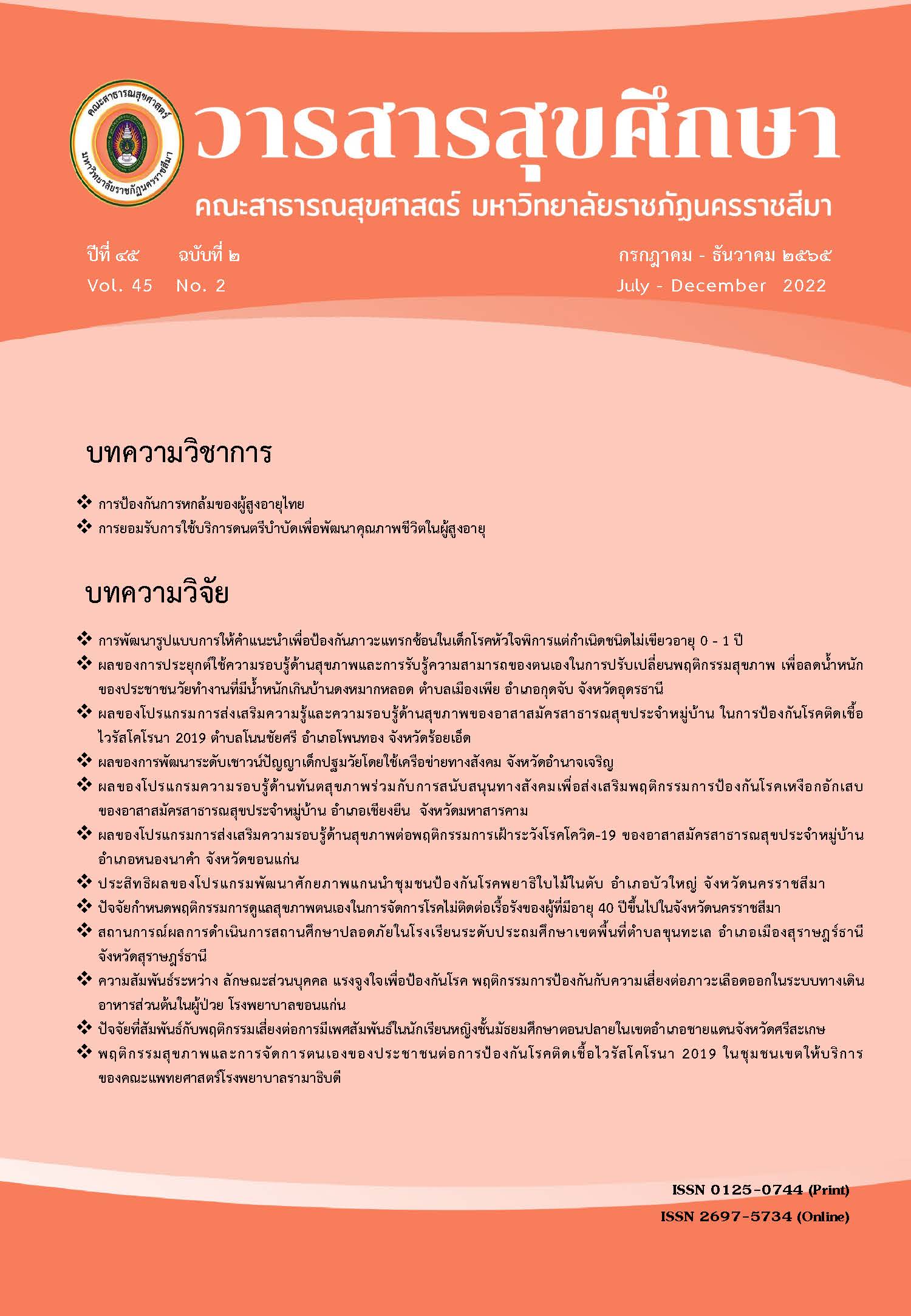Health Behavior and Self-management to Prevent Covid-19 Among People Live in Community Service Area of Faculty of Medicine Ramathibodi Hospital
Main Article Content
Abstract
Information on people's health behaviors and self-management in the prevention of coronavirus disease 2019 to help community nurses create nursing plans for health promotion and prevention. The objective of people's health behaviors and self-management is to prevent covid -19 in the community service area of the Faculty of Medicine Ramathibodi Hospital. These are 8 slum communities, selected samples from the data collection during March - April 2020 from the record of health behavior and self-management of people towards the prevention of covid-19 with complete information. A total of 496 samples were obtained. Descriptive statistic was used to analyze.
The result showed that majority of people take action to prevent covid-19 in more than 90.00% of critical issues. For example, wearing a mask when going outside, washing hands often with soap and water, covering mouth and nose when coughing/sneezing, and washing hands immediately, avoiding and touching the face, eyes, nose, and mouth. And keep a distance of 1-2 meters from other people, etc. Most people follow government policies such as refraining from traveling between Bangkok and other provinces abroad 97.38 %, people who have come into contact with or are in close contact with a patient infected with covid-19 will be quarantined 92.14 %, refraining from being at risk of the covid-19 82.46 %, use personal eating utensils such as spoons/glasses/dishes 79.43%. Needs and opinions to prevent covid-19, People need facemasks/ cloth masks, alcohol gel, reliable sources and health consulting 24 hours, enough service points for vaccination, a service point for temperature measurement risk screening and surveillance of infection in the community, having regular publicity for voice the calls in community, Having a knowledge board of covid-19 and the process of receiving services/transfer system from home to hospital, etc. Using right information from this research by providing and supporting that people need will help increase their potential to take care of themselves.
Article Details

This work is licensed under a Creative Commons Attribution-NonCommercial-NoDerivatives 4.0 International License.
References
World Health Organization. Coronavirus disease (COVID-19) [Internet]. 2022. [cited 2022 Sep 15]. Available from: https://www.who.int/news-room/q-a-detail/coronavirus-disease-covid-19.
Department of Disease Control, Ministry of Public Health (Thailand). The situation of COVID-19 infected with daily update visualization [Internet]. 2022. [cited 2022 Sep 16]. Available from: https://ddc.moph.go.th/covid19-dashboard/.
World Health Organization. Classification of omicron (B.1.1.529): SARS-CoV-2 variant of concern. [Internet]. 2022. [cited 2022 Sep 17]. Available from: https://www.who.int/emergencies/diseases/novel-coronavirus-2019/question-and-answers-hub/.
Kaendera S, Leigh L. Five things to know about Thailand’s economy and COVID-19 international monetary fund. [Internet]. 2022. [cited 2022 Sep 20]. Available from: https://www.imf.org/en/ News/Articles/2021/06/21/ na062121-5-things-to-know-about-thailands-economy-and-covid-19. June 23, 2021.
Jitsuchon S. The social impact of the COVID-19 outbreak new ripples and measures that should be taken. [Internet]. 2022. [cited 2022 Sep 20]. Available from: https://tdri.or.th/2021/01/impact-of-new-covid-19-wave/. (in Thai)
Abdel-Latif MMM. The enigma of health literacy and COVID-19 pandemic. Public Health. 2020; 185:95-6. doi: 10.1016/j.puhe.2020.06.030. Epub 2020 Jun 19. PMID: 32593054; PMCID: PMC7303647.
Abel T, McQueen D. Critical health literacy and the COVID-19 crisis. Health Promot Int. 2020; 35(6):1612-3. doi: 10.1093/heapro/daaa040. PMID: 32239213; PMCID: PMC7184450.
Shahnazi H, Ahmadi-Livani M, Pahlavanzadeh B, Rajabi A, Hamrah MS, Charkazi A. Assessing preventive health behaviors from COVID-19: a cross sectional study with health belief model in Golestan Province, Northern of Iran. Infect Dis Poverty. 2020; 9(1):157. doi: 10.1186/s40249-020-00776-2. PMID: 33203453; PMCID: PMC7671178.
Pattarateeranon P, Sriyoha N, Sreeprasarn P, Saowanee R. Role of Community Nurses in Health Promotion and Prevention of Coronavirus 2019 Pandemic in 8 Community Responsible Area, Ramathibodi Hospital. TH. J. of Health Edu. 2021; 44(1): 1-11. (in Thai)
Ratchakul J, Suwannit C, Taungratananon T, Ruangsom P, Hatsaro J, Wibunpan S. Survey of public perspectives toward population adherence to COVID-19 mitigation policy following the outbreak in the first half of 2021. International Health Policy Program, Ministry of Public Health. [Internet]. 2022. [cited 2022 Apr 12]. https://www.ihppthaigov.net/
Heinrich-Heine-University. G*Power: Analyze different types of power and compute size with graphics options. [Internet]. 2022. [cited 2022 Apr 19]. Available from: https://g-power.apponic.com/.
Heinrich-Heine-University. G * Power 3.1 manual. [Internet]. 2022. [cited 2022 Apr 19]. Available from: https://www.psychologie.hhu.de/fileadmin/redaktion/Fakultaeten/Mathematisch-Naturwissenschaftliche_Fakultaet/Psychologie/AAP/gpower/GPowerManual.pdf.
Zhong BL, Luo W, Li HM, Zhang QQ, Liu XG, Li WT, Li Y. Knowledge, attitudes, and practices towards COVID-19 among Chinese residents during the rapid rise period of the COVID-19 outbreak: a quick online cross-sectional survey. Int J Biol Sci. 2020; 16(10):1745-52. doi: 10.7150/ijbs.45221. PMID: 32226294; PMCID: PMC7098034.


